The beach-entry phenomena: Staying afloat with current trends in fibreglass pool design
by habiba_abudu | September 23, 2019 2:28 pm
By Edward Vondell
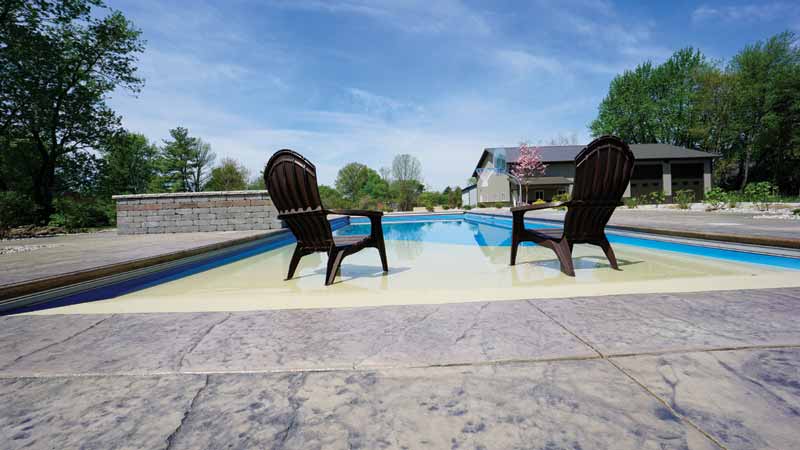 [1]
[1]As with many trends in residential pool construction, the beach-entry pool is another feature that comes from the resort industry. Today, when consumers go on vacation to hotels and experience the benefits of a beach entrance on a pool, they want one in their backyard. Until now, the only way to achieve a zero-depth beach-entry pool was to build one out of gunite.
Pool installers have been using their expertise to create this hard-to-build entry feature for clients, but have been asking fibreglass pool suppliers to create a beach-entry design—to make it easier to offer this feature. In the spring of 2019, Jonathan Hendrick, co-owner of Hendrick Pool and Lawn Service in Indiana, installed his first rectangular beach-entry pool, while David Burton, CEO of Burton Pools & Spas in Arkansas, completed a free-form beach-entry pool. From sales to installation, these builders have had a positive experience with this offering and believe more consumers now prefer a unique, resort-style pool in their backyards.
Diving into the market
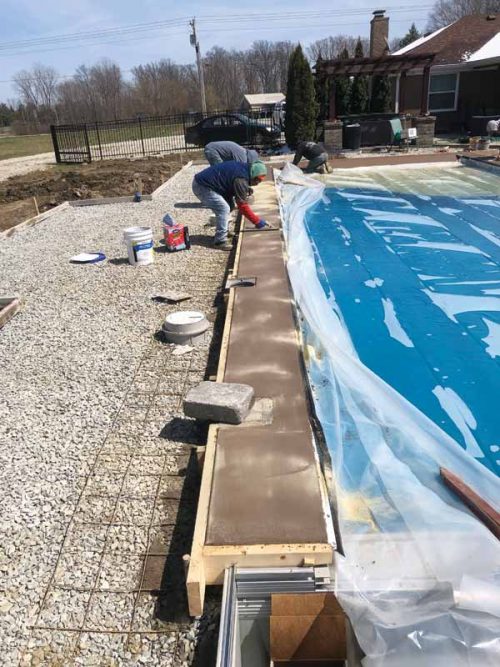 [2]
[2]The beach-entry pool appears to be the next trend, following the popularity of in-pool sun decks and tanning ledges.
“We’ve been watching the residential pool market follow the designs of those in hotels and resorts because consumers want something different from their neighbours,” says Hendrick, who has been building vinyl liner and fibreglass pools with his father for more than 35 years.
They believe the beach-entry pool is a natural next step in the evolution of high-end features.
David Burton, who builds gunite, vinyl liner, and fibreglass pools, has been in the business for more than 41 years.
“By offering all three types of pools, we aren’t biased toward one construction type or another,” says Burton. “Once we know what customers want, when they want it, and what they can afford, we can steer them in the direction of a gunite, vinyl liner, or fibreglass pool.”
Burton feels the market has always been interested in beach-entry pools.
“When someone tells you they want this type of pool, there is a specific reason for it,” says Burton. Many times, consumers want this type of pool because they have small grandchildren, older dogs, or have a disability or injury that makes the beach entry appealing.
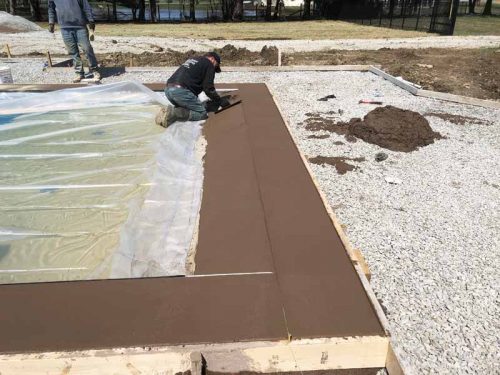 [3]
[3]“When a homeowner requests a beach-entry gunite pool, they are often shocked to learn the feature will add $10,000 to the price of the pool,” explains Burton. “Part of the reason is, with a gunite beach entry, we must use several specialty products for the transition section alone to make it all work. Not to mention having to comply with codes for the slope, etc. It’s very time consuming.”
In the case of a fibreglass pool, there is no ‘additional’ cost to the beach entry—it is a part of the pool design. The slope is pre-designed and engineered to meet codes, and the final product has a consistent, finished look.
Bringing zero-entry fibreglass pools to builders
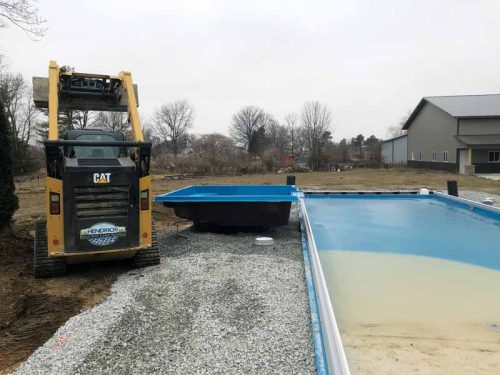 [4]
[4]It took several years to create a zero-entry fibreglass pool. The texture of the entry and the construction of the transition to the deck were some of the biggest challenges. The pool had to meet all the legal, as well as safety requirements. It was important the surface had traction, but did not rip up the feet of bathers; therefore, it had to be comfortable and consistent throughout.
The transition from the zero-depth beach entry to the deck turned out to be an engineering challenge. The concrete had to be thick enough to withstand the freeze-thaw weather conditions. Hence, a patent-pending flange was created, which allowed the concrete to meet the deck at a zero-depth entry. This patented design was particularly important, as without the flange support, the concrete would only be 25.4 to 38.1 mm (1 to 1.5 in.) thick. The builders did not feel the need for a 76.2 to 89-mm (3 to 3.5-in.) thick concrete transition, as this would create a ‘step down’ and tripping hazard and would not be a zero-depth entry pool. The flange allows the connection between the pool and the deck to be structurally sound and esthetically pleasing.
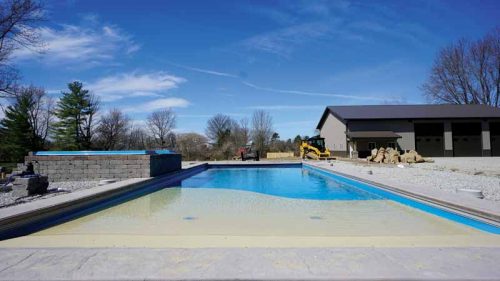 [5]“Customers are choosing fibreglass pools at a rapid rate, and these sales—in our region—are growing much faster than other pool types,” says Burton. “Many buyers are choosing those with large tanning ledges and sitting areas with benches. These features are by far the most popular among consumers.
[5]“Customers are choosing fibreglass pools at a rapid rate, and these sales—in our region—are growing much faster than other pool types,” says Burton. “Many buyers are choosing those with large tanning ledges and sitting areas with benches. These features are by far the most popular among consumers.
I believe this type of pool will really help us stand out from our competitors.”
Hendrick agrees: “Fibreglass pools can be a better solution when it comes to shallow areas, such as tanning ledges and beach entries, as you don’t need to worry about what type of furniture is brought into the area, or how long the nails are on the dogs that run into that zone. Not only is it a better solution for homeowners, but it appears nine out of 10 dogs prefer beach-entry pools… from what I’ve seen on this first installation.”
Fibreglass surfaces do not get damaged by any type of backyard furniture a customer might pull into the pool. One can even put an umbrella into the beach-entry area, right into the fibreglass floor, and enjoy the sun.
Installation process
 [6]
[6]The real difference between a beach-entry fibreglass pool and a traditional gunite or concrete-type beach entry is the ease of installation. It takes a lot less time to put in a fibreglass pool than a traditional beach-entry pool, which is one of the reasons professionals include fibreglass as part of their pool construction offering. The reduction in the overall time also minimizes the need for labour and, thus, allows builders to install more pools.
“Since we have experience building beach-entry pools in gunite, it is easy for us to discuss this option with homeowners,” explains Burton. “It’s important for the client to realize that because of the large, slow-transition slope, there will be less swimming room compared to a pool of the same size with a large tanning ledge that you can step into.
“We found the fibreglass beach entry was much easier to build than a gunite one,” says Burton. “There is a lip around the entire perimeter of the pool that makes it much easier to pour up to the edge.”
It is also advantageous to add a fabricated structure that supports the ledges with backfill and allows a sturdy and level installation. Typically, crushed stone or flowable fill is used under the beach-entry area. But, if the backfill is not completed properly, the ledge can feel hollow when stepped on. Over time, the fill can also shift and settle, creating a void. The last thing an installer wants is a potential crack in the pool. “We have been using a patent-pending backfill eliminator on all our fibreglass installations that have large tanning ledge areas,” says Burton. “It’s faster and hassle-free. Although it adds to the overall cost, it’s something we strive to include in the price of the pool because it saves time and is worth the money.”
“The installation of our first beach-entry pool was really quite simple,” says Hendrick. “It wasn’t much different from installing one of the large fibreglass pools with a tanning ledge. Basically, you just need to keep the same angle of the pool all the way into the deck. It’s about a 10 per cent grade, and you just need to run the concrete out to where the pool and deck meet. So, for example, with the coping, which adds about 51 mm (2 in.) of height, you only need to run the concrete out about
305 mm (12 in.).
“On this particular project, we also installed a pool cover,” says Hendrick. “The fibreglass pool is particularly well designed for including an automatic pool cover. It adds about 76.2 mm (3 in.) of height, so we had to come out a little further to make the two grades meet.
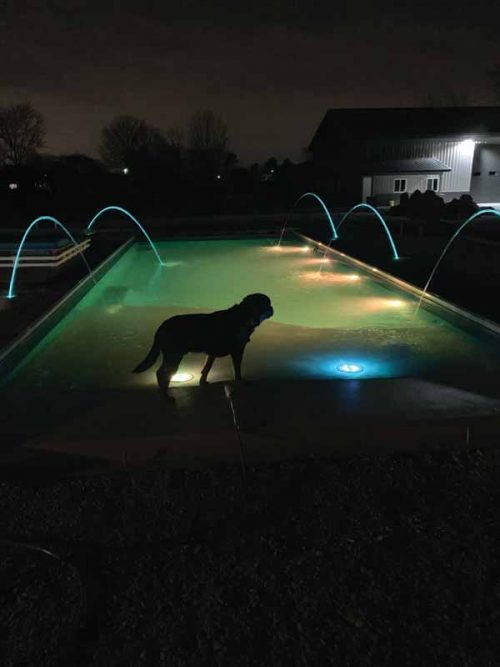 [7]
[7]A fibreglass beach entry has many advantages compared to a gunite pool. First, one does not need to worry about freeze-thaw conditions. On the other hand, the shallow area in a gunite pool is susceptible to cracking; therefore, it needs additional product treatments to prevent damage. In addition, the porous nature of gunite requires more maintenance than fibreglass, especially in the beach-entry area. When the water is shallow, it is more stagnant and warms up faster, making it an ideal place for algae to grow. Even if one adds more returns, there is a higher chance of algae clinging onto the surface in the beach entry, which will require thorough cleaning, as it can make the area more slick and potentially a slip hazard. With a fibreglass pool, the texture is built into the design and complies with the safety requirements. Therefore, these pools are easy to clean as the surface is non porous, making it easier to remove any algae that may start to develop.
Conclusion
Now that beach-entry design features are available in fibreglass, pool builders can offer these unique pools to clients. Much like the initial introduction of tanning ledges, consumers may start to see this option and invariably ask builders to create a beach-entry pool in their backyard.
“When we first posted the availability of the pool on our website, we received more than 50 requests from homeowners who asked to be added to the waiting list to get one installed that season,” says Khamis.
Burton agrees there will continue to be a growing demand for beach-entry pools, especially now that they are available in fibreglass, too.
“This was the case with our very first beach-entry pool,” explains Burton. “When the client learned, almost nine months ago, that we would be able to install a beach-entry fibreglass pool, she was willing to wait, because she really wanted a pool in which she didn’t have to step down, and this option was the perfect fit.”
“We are a family business and our reputation is everything,” says Hendrick. “Now that we have installed this type of pool, we are ready to start promoting to everyone.”
 [8]Edward Vondell is co-owner and chief operating officer of the fibreglass pool manufacturer, Thursday Pools LLC—a position he has held since 2012. Prior, he was employed with Chrysler Corp. He earned his bachelor’s degree in engineering from Purdue University in 1985 and an MBA from the University of Notre Dame in 2001. Vondell is vice-president of the Indiana Chapter of the Association of Pool and Spa Professionals (APSP). He is a successful inventor of automotive and fibreglass pool innovations and their accessories and has five products patented and multiple patents pending.
[8]Edward Vondell is co-owner and chief operating officer of the fibreglass pool manufacturer, Thursday Pools LLC—a position he has held since 2012. Prior, he was employed with Chrysler Corp. He earned his bachelor’s degree in engineering from Purdue University in 1985 and an MBA from the University of Notre Dame in 2001. Vondell is vice-president of the Indiana Chapter of the Association of Pool and Spa Professionals (APSP). He is a successful inventor of automotive and fibreglass pool innovations and their accessories and has five products patented and multiple patents pending.
- [Image]: https://www.poolspamarketing.com/wp-content/uploads/2019/09/DSC08662.jpg
- [Image]: https://www.poolspamarketing.com/wp-content/uploads/2019/09/IMG_1221.jpg
- [Image]: https://www.poolspamarketing.com/wp-content/uploads/2019/09/IMG_1222.jpg
- [Image]: https://www.poolspamarketing.com/wp-content/uploads/2019/09/IMG_0994.jpg
- [Image]: https://www.poolspamarketing.com/wp-content/uploads/2019/09/DSC08607.jpg
- [Image]: https://www.poolspamarketing.com/wp-content/uploads/2019/09/IMG_1720.jpg
- [Image]: https://www.poolspamarketing.com/wp-content/uploads/2019/09/IMG_0925.jpg
- [Image]: https://www.poolspamarketing.com/wp-content/uploads/2019/09/Author_headshot2-1.jpg
Source URL: https://www.poolspamarketing.com/trade/features/the-beach-entry-phenomena-staying-afloat-with-current-trends-in-fibreglass-pool-design/